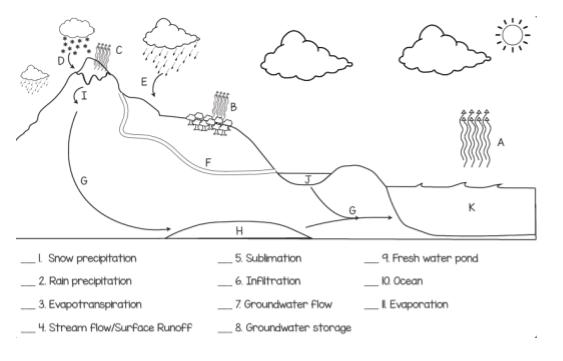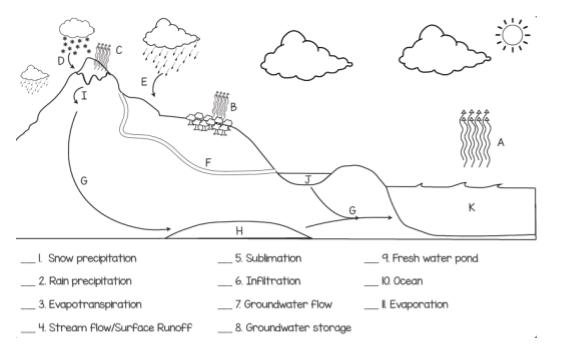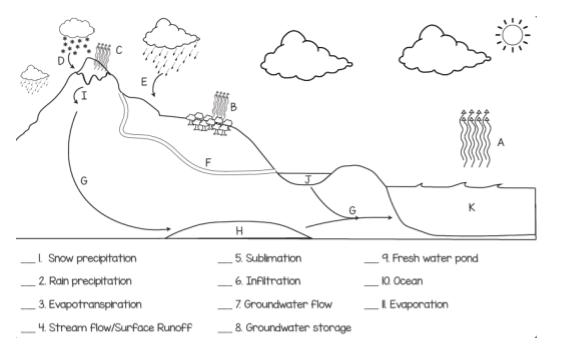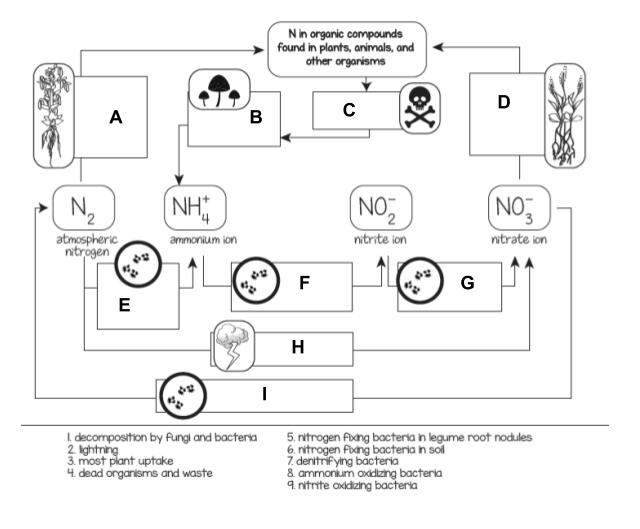this location in the world has the most water?
What is the ocean?
The location of most of nitrogen on earth.
What is the atmosphere?
This cycle is different from other biogeochemical cycles because it is missing this/
What is a gas phase?
The carbon cycle is a _________ system.
What is closed?
Of the total biomass available at a given trophic level only about this percentage can be converted into energy at the next higher trophic level.
What is 10%?

3
What is B?
The ion of nitrogen that is most easily metabolized by plants
What is nitrate (NO3-)?
The only way humans can obtain phosphorus is by this method.
What is mining?
Humans have been adding CO2 in the atmosphere at a rate faster than natural systems remove it through this process.
What is the combustion of fossil fuels?
A model of how energy and matter move through two or more interconnected food chains.
What is a food web?

Location of 7.
What is G?
The process that produces the form of nitrate most easily metabolized by plants/
What is nitrification?
When excess phosphorus enters waterways it can stimulate a sudden and rapid growth of algae called an ______ ________.
What is an algal bloom?
CO2 dissolved into the ocean is taken up by photosynthetic organisms and sedimentation. This process releases he CO2 back into the ocean and atmosphere.
What is respiration?
We can represent the distribution of biomass, numbers, or energy among trophic levels with this.
What is a trophic pyramid?

Location of Sublimation
What is C?
The process where excess nitrogen runoff into aquatic ecosystems creates an excess of algal growth followed by an increase in decomposition activity which depletes the oxygen in the water.
What is eutrophication?
Unlike nitrogen, phosphorus rarely changes forms and is most commonly found in this form.
What is phosphate (PO43-)?
This is an abiotic source of carbon in the atmosphere.
What is volcanic activity?
If gross primary productivity in a wetland is 20,000 kcal/m2/year and respiration is 12,000 kcal/m2/year, the net primary productivity of the wetland is_______.
What is 8,000 kcal/m2/year.
This process is most affected by deforestation.
What is precipitation?

3 Locations where Nitrogen gas is transformed into ammonium.
What is H, E, and A?
The 5 processes that drive the phosphorus cycle. (name all 5)
What is assimilation, mineralization, sedimentation, geologic uplift, and weathering?
The greatest impact of extra atmospheric CO2.
What is climate change?
These are 2 reasons why not all energy is transferred from one trophic level to another.
What is not all energy is usable (digestible) and some energy is used by the organism (moving, eating, maintaining body temp)?